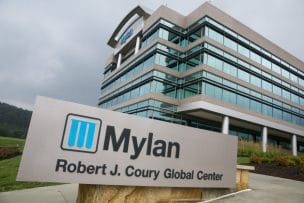Amid a firestorm of controversy over price hikes on lifesaving EpiPens, drug manufacturer Mylan made a dramatic and unusual move this week – it announced the launch of a lower cost generic replica of its own brand-name epinephrine auto-injector.
Mylan has been under relentless pressure over the price of EpiPens since it surfaced that the list price for a set of two devices reached $609 this year. That’s an increase of more than 500 percent from 2008. To alleviate sticker shock at pharmacy counters, Mylan CEO Heather Bresch’s initial response was to announce a discount savings card of $300 on Aug. 25, 2016. That tripled the value of an existing $100 savings card.
But politicians with drug pricing on their radar weren’t placated. They contend this wasn’t adequate relief, especially for families whose children need to carry the devices in case of an anaphylactic emergency. In an attempt to quell the furor, five days later Mylan announced its generic version of the EpiPen. It will have different labeling on the identical device for half the price.
Yet with protests at Mylan headquarters, social media outrage and petitions signed by hundreds of thousands of Americans, the EpiPen price controversy isn’t going to be quickly resolved. Allergic Living delves into the key issues involved.
EpiPen vs. Generic Price Issue
Critics of Mylan’s EpiPen price increases have been asking: Why doesn’t Mylan just cut the price of the EpiPen two-pack?
Ronny Gal, an investment analyst with Sanford C. Bernstein who specializes in the pharmaceutical sector, explains that while Mylan could roll back its price, it’s hard to say how that would affect the costs that insurance companies pass along to consumers. He and other industry watchers have said that pharmacy benefits managers (PBMs) and their insurer clients ultimately set the charges to consumers through their co-pays and the size of deductibles in the insurance plans.
Gal’s view is that PBMs and insurers, who reimburse pharmacy drug charges, were none too pleased to see Mylan take two sizable price increases within the past year. (He estimates these as a 27 percent net increase for the company.)
With respect to EpiPens, “the payers got mad and raised the pain level on patients – raising copays and toughening medical policies,” Gal wrote to Bernstein’s investment clients.
He explained the process to Allergic Living. When a drug price goes up, the PBM can decide whether to absorb all of the price difference, and transfer some of it to the patient. Or, it can choose not absorb the increase at all, and transfer it fully to the patient.
“In this case, the employer [the insurer] seems to have said: ‘If you’re going to be nasty and raise prices so much, we’re not going to absorb this,’” Gal said.
In addition, some consumers have opted for lower-premium insurance plans. These require them to meet higher deductible levels before coverage kicks in. In such cases, they were hit with the cost of $609 per two-pack or more – since families often have an EpiPen set for school or work while the allergic person also carries a set. Back-to-school season hit and parents showed up to refill annual auto-injector prescriptions. That’s when the shock hit at the pharmacy counter, and a price backlash was born.
EpiPen Price: Who Benefited?
Mylan CEO Heather Bresch contended in an Aug. 25 CNBC interview that large rebates to PBMs and, to a lesser extent, fees to distributors and pharmacies, meant she couldn’t control the ultimate price charged to consumers. Gal’s view is that “Mylan is right, partially, in saying that a lot of people along the way make money, it’s not just us.”
However, he is quick to add that the company still bears the brunt of responsibility: “Mylan did increase its revenue per unit at least two times in one year.”
David Maris, a Wells Fargo senior analyst who predicted in June that some of Mylan’s drug price increases could attract “headline risk,” took greater issue with Bresch’s stance on the role of middlemen. “It’s a real challenge to understand how a management team sits around a board table and makes a decision to raise the price of a lifesaving medication over and over and over. Yet, when the P.R. storm hits, decides to blame someone else for that price increase,” Maris told The New York Times.
Will EpiPen Generic Calm Price Furor?
Gal thinks while negative headlines will persist, the company will get some marks from consumers and insurers for the generic’s introduction. In a note to investors, he and his Bernstein colleagues wrote that the PBMs and insurers set the costs paid by patients through deductibles and co-pays, and that these commonly differ between brands and generics. Thus, his team said: “there will be some automatic reduction of cost to patients from availability of generics; some payers [PBMs] may respond by alleviating medical policies; retailers selling the generics to self-pay patients could not charge much more than $300 (at the current environment), helping alleviate that cost.”
However, Mylan’s solution to provide a half-price generic certainly has not quelled politicians’ criticisms of the spike in the price of the EpiPen. In fact, the House Oversight Committee is now asking Mylan for numerous documents related to sales, pricing and profits on the branded device, while a group of 20 Democrat senators have demanded similar specifics. The political pressure has just begun.
“Mylan may appear to be moving in the right direction, but its [generic device] announcement raises as many questions as solutions – including why the price is still astronomically high, and whether its action is a preemptive strike against a competing generic,” said Sen. Richard Blumenthal (D-Conn.).
Where is the Drug Competition?
As Blumenthal indicates, there is now a lot of discussion of the lack of competition and how the EpiPen price rose sharply in a monopoly environment after Sanofi withdrew the Auvi-Q auto-injector from the marketplace in October 2015. (This followed reports of potential issues with the dosage delivered by the Auvi-Q.)
A health policy analyst at the non-profit Kaiser Family Foundation also suggests that “the introduction of a lower-priced generic version may keep competitors out of the market.”
But Gal sees the entire situation increasing pressure on the FDA to move quickly to approve a epinephrine product competitor. “One thing I would expect to happen here is that anything to do with epinephrine moves to the top of the pile” in terms of application reviews, he told Allergic Living. “I think that’s going to happen.”
An auto-injector from Teva Pharmaceuticals had been expected for early 2017, but the regulator rejected the application, citing “major deficiencies.” Similarly, the agency also turned down an application for a pre-filled epinephrine syringe from Adamis Pharmaceuticals. Both companies have indicated they will resubmit approval applications.
There is a generic version of the Adrenaclick auto-injector currently on the market, but it is so far not widely prescribed and many states don’t allow it to be substituted in pharmacy formularies. The rights for the Auvi-Q, which had gained a sizeable share of the auto-injector market, now reside with its inventors at Kaléo Pharmaceuticals. Company officials indicate they are planning for its return. The smaller device was voluntarily recalled in the fall of 2015, so it remains approved. Regarding the timing of re-entry, a Kaléo spokesperson would only say: “We are monitoring the conversation and situation very closely.”
The not-for-profit FARE (Food Allergy Research & Education) says competition is definitely something the allergy community wants, and that the organization has been encouraging. “The Auvi-Q could be the soonest one because it won’t require FDA regulatory activities,” says Dr. James Baker, FARE’s CEO. “I think both Teva and Adamis are coming back in.”
He says another possibility is the entrance of the Emerade auto-injector, which is well-known in Europe. “I think we really need five or six products in the marketplace before competition will work effectively,” said Baker. He’s an allergist who was formerly the CEO of a biotechnology firm and he’s familiar with the process of bringing drugs to market.
Drug Pricing – Lack of Transparency
In the U.S. pharmaceuticals market, we’ve seen egregious examples of Valeant and Turing Pharmaceuticals price surges – with a 5,000 percent spike on Turing’s drug to combat a life-threatening parasitic infection.
But there have also been big increases more in keeping with the EpiPen’s steady upward climb. For instance, one study found that the average multiple sclerosis patient was charged $60,000 a year for drugs in 2013, about a 600 percent increase in a decade. A Bloomberg investigation in June showed that 30 of 39 medicines analyzed had recorded price increases more than double the rate of inflation over seven years. Cancer and rheumatoid arthritis medicines are among those with eye-widening price tags.
Industry analysts, including Ronny Gal, think the steady rise in price for insulin, which many diabetics require daily, will also soon invite political and headline attention.
In this epidemic of price hikes, manufacturers (including Mylan) argue that it isn’t just them taking more money. The pharmacy benefit management groups, which negotiate better drug prices for insurers and employer clients, take rebates – and the drug companies contend they increasingly want a bigger cut. A Tufts University analysis released in May 2016 found that rebates paid to the PBMs play a key role in determining which drugs are offered to patients when there is competition.
But none of these price negotiations are openly discussed. The PBMs say the price spikes in cases such as the EpiPen shouldn’t be turned into an insurance coverage issue. And while nobody is about to let the pharma makers like Mylan off the hook for their big increases, clearly this whole system – with prices negotiated under a cloak of secrecy – needs fixing.
At the start of the EpiPen furor, Forbes columnist Matthew Herper published a compelling column about fixing America’s drug pricing mess. As an experienced pharma watcher, he makes the case for drug pricing transparency, the FDA to get cracking on allowing competition in the epinephrine auto-injector market and for price hikes to be tied to genuine innovation.
These are excellent points to raise. Especially so for those of us or our children who must rely on not just always carrying – but also affording – a lifesaving medication like epinephrine.






